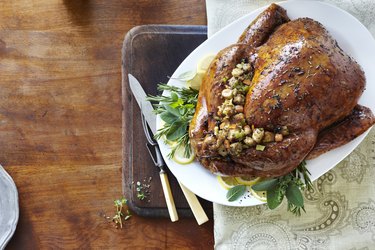
Brining a turkey in a solution of water and salt before cooking is an almost foolproof method for producing a moist and tender main dish. As long as you don't overcook the bird, you're guaranteed a juicy bite of white or dark meat. An ice chest is a great turkey brining container if you just don't have room in the fridge, but you need to keep a few simple food safety rules in mind.
Basic Brine
Video of the Day
Variations on brine recipes abound, but the basic rule of thumb is to use two cups of table salt (four if you're using kosher salt) per two gallons of water. Add one cup of sugar for each two cups of salt.
If you make the brine in a large pot on the stove, the sugar and salt will dissolve more quickly, but you must cool down the brine before you add the turkey. You can cool the brine quickly by adding ice, but keep in mind that the ice will dilute the solution, so adjust the ratios accordingly.
Brine Seasonings
Some cooks like to add herbs and spices to the brine to impart more flavor to the turkey. Martha Stewart's turkey brine instructions include bay leaves, juniper berries, fennel, coriander, garlic and mustard seeds.
For a Cajun or south-of-the-border twist with hints of heat, add chili, onion and garlic powders, cayenne, thyme and oregano to the brine. Use soy sauce and ginger for Asian flavors, or add a drop or two of liquid smoke to bring a flame-cooked flavor to the meat.
Brining the Turkey
Place a thawed or fresh turkey in a large cooking bag or other food-safe bag. These are usually found in the paper products section of the store, near the aluminum foil and plastic wrap.
Pour the brine over the turkey, squeeze out the extra air and close the bag tightly. The entire bird should be immersed in brine.
Cooler Brining
Place a layer of ice on the bottom of the cooler and set the turkey on top. Add ice to cover the turkey and close the cooler. Set it out of the way — if you have curious children or pets, put a heavy pot or a couple of cookbooks on top.
Chill for six to eight hours. If you're brining overnight, reduce the salt and sugar amounts by half, or the turkey will be too salty. Check the temperature inside the cooler occasionally to make sure it stays at 40 degrees Fahrenheit or below. Fifteen pounds of ice should keep a 20-pound turkey cool for up to 12 hours.
After the Brine
Once the turkey is brined, remove it from the cooler, pour off the liquid, rinse and pat it dry.
If not cooking it immediately, some chefs recommend air-drying the turkey. Put it on a baking sheet and place it in the fridge, uncovered, overnight. This makes for a crispier skin.
Thawing a Frozen Turkey
The USDA recommends three methods for thawing frozen turkey. The internal temperature of the turkey must remain below 40F, so thawing on the counter or even on a chilly back porch is not recommended.
Refrigerator Thawing
The best place to thaw your turkey is in the refrigerator. It takes 24 hours for every four to five pounds, or up to six days for a very large bird, so plan ahead. Once the turkey is thawed, it will keep in the refrigerator for up to two days.
Thawing With Cold Water
Cold-water thawing is quicker, but it requires more attention. Put the turkey in packaging that won't leak and surround it with cold water in the sink or another container large enough to submerge the bird. Change the water every half-hour — it takes about an hour to thaw one pound. Cook the turkey immediately after it's thawed.
Microwave Thawing
If your bird is small enough and your microwave big enough, you can thaw it in the microwave. Follow the manufacturer's defrosting instructions, and cook the turkey immediately after it's thawed.
Safety Tips
- Never put an unwrapped turkey in a cooler. Use a food-safe cooking bag large enough to immerse the turkey in the brine before placing it in the cooler. Close the bag securely.
- Bacteria grow quickly above 40F, so you must keep the temperature in the cooler at or below that temperature. An appliance thermometer, available for under $5 at big box stores, will provide an accurate reading of the temperature inside the cooler. Check it often, and add ice as needed.
- Full coolers hold cool temperatures best, so don't use an oversized chest for turkey brining.
- Choose a smaller bird if you're planning to brine turkey in a cooler. The brine will work its magic more quickly, and you won't have to leave the turkey unrefrigerated as long.
- A cooler with a drain is ideal, so you can remove water as it melts.
Check out this related video from ExpertVillage on Youtube
- Martha Stewart: Turkey Brine
- Cook’s Illustrated: How to Brine Turkey in a Cooler
- University of Illinois Extension: Turkey for the Holidays, Cooking Techniques
- USDA: Turkey Basics, Safe Thawing
- Foodsafety.gov: Chill, How to Pack a Cooler to Prevent Food Poisoning
- Foodsafety.gov: Turkey Roasting Chart